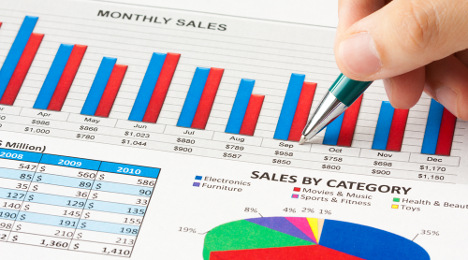Perhaps coming up against the difficult year-over-year comparison analysts noticed on the new-car side, TrueCar is projecting a slight softening in used-vehicle sales this month.
TrueCar forecasted that March’s total used sales, including turns at franchised and independent dealerships as well as private-party transactions, may exceed 3,581,085, which would be down 0.9 percent compared with March of last year.
Meanwhile, the firm projected the pace of March new-model sales should expand to a seasonally adjusted annualized rate (SAAR) of 16.9 million new units on continued strong consumer demand even with one less weekend than a year ago and harsh weather conditions across the country.
TrueCar contends new-vehicle sales, including fleet, should reach 1,524,700 units for the month, down 0.8 percent from a year ago. Adjusting for one less selling day compared with March of last year, deliveries should rise 3.1 percent on a daily selling rate (DSR) basis, while the SAAR is up from 16.5 million.
Eric Lyman, vice president of industry insights for TrueCar, described factors that might be impacting new-vehicle showroom traffic, but they may as well be influencing potential buyers of used vehicles, too.
"Spring has officially sprung, but much of the country is still pushing away snow piled up at the doorstep,” Lyman said.
“Given what a strong month last March was, this slight decline in total volume isn't surprising,” he continued. “We’re bullish on the retail outlook for the second half of the year and the industry remains on track to reach TrueCar's 17 million-unit projection for 2015.”
TrueCar also mentioned the new-vehicle sales expansion, on pace to rise for a sixth consecutive year, coincides with improving economic indicators including GDP, housing starts, the Dow Jones Industrial Average and wages and salaries, all of which are projected to strengthen in 2015.
Similarly, new home sales reached a seven-year high in February while the Consumer Price Index edged up 0.2 percent after three straight months of declines, according to analysts.
TrueCar went on to note Subaru may be the biggest gainer in new-model sales, followed by Honda and Toyota, with respective increases of 10.6 percent, 4.5 percent and 4.2 percent.
Analysts added FCA and its Chrysler, Jeep, Dodge, Ram and Fiat brands, should report a 1.3 percent gain even compared with strong volume registered a year ago. This forecast should result in 60 consecutive months of year-over-year of sales gains for FCA.
Lyman closed by sharing that incentive spending by automakers averaged $2,691 per vehicle in March, down 1.3 percent from a year ago and up 0.4 percent above February.
“It’s positive that incentives aren't rising from the year-ago level,” Lyman said. “This and steady demand for light trucks means automakers can expect continued revenue gains.”
It may sound like a broken record that the discussion of automotive technicians has once again surfaced in one of the largest auto group’s quarterly conference calls.
But Lithia Motors president and chief executive officer Bryan DeBoer touched on another interesting angle regarding how fuel prices affect the automotive industry — the service side.
When asked how the lowering fuel prices affected Lithia’s sales in fuel-producing states, DeBoer said his company is seeing a bit of a “yin-and-yang benefit."
“In Q4, I think what we really saw was a mix shift from new vehicles to used vehicles. The oil states performed slightly lower than the rest of our states in Q4,” DeBoer said. “If you want a little more color of what’s happening in January — Alaska was up 28 percent year over year in total revenues. North Dakota, which is highly based energy state, even though we’re (selling) in the eastern part of the state, was up 4 percent. And Texas was up about 3 (percent), which is a little bit behind. It still seems strong, though, we’re still pleased.
“It’s a robust economy, there’s no question about it. And if there’s one thing we could say is an opportunity (it's that) some of those pump jacks are now not running, which means that those technicians that aren’t fixing the broken ones are coming back into our company and can now fix the cars that are now in service,” DeBoer continued, “which we all know the throughput in service in cars is a much higher rate than what it is in new vehicles and used-vehicles sales.”
Lithia experienced a 12-percent growth in service, body and parts sales on a same-store basis in Q4 of 2014, which DeBoer said was by no means an unexpected jump and should be expected to increase further in the future. When asked what prompted the strong growth in service sales, DeBoer pointed to an increase in customers simply choosing to come back to Lithia for work on vehicles they had purchased from the company.
“It’s primarily driven solely off of units in operation,” DeBoer said. “Despite us being up 12 percent in aggregate in fixed operations — yeah, it’s (sales) driven off warranty, and it’s driven off customer pay — primarily still we have probably half of our stores that are considerably below that 12-percent level (in service sale growth) and that haven’t reinvented themselves to be able to attract our consumers back to our stores and be able to meet their needs when it comes to a cost proposition or a time proposition.
“To us, 12 percent is just keeping pace with the units in operation growth,” DeBoer later continued.
For DeBoer, he thinks his company can still do better when it comes to convincing customers to bring their vehicles back for service.
“We believe that there’s still a lot of opportunity out there within our existing Lithia stores," he concluded.
Used-vehicle sales appear headed for a month well north of 3 million units, according to TrueCar, which released its February forecast Monday that called for the possibility of nearly 3.32 million used sales for the month.
That projected figure includes sales from franchised and independent dealers as well as private-party transactions. It would be a 1.5-percent year-over-year gain.
Overall, the used-car market may reach its second straight year of sales growth during 2015, which would mark the fifth time in six years that used sales have improved, according to Edmunds.com.
In its 2014 Used Vehicle Market Report, Edmunds estimated that there will likely be 36.5 million used sales in 2015, which would beat the year-ago sum of 35.91 million used sales. Edmunds’ breakdown of year-by-year used-car sales can be found below:
Year Used-Vehicle Sales
2007 38,279,709
2008 36,145,967
2009 35,621,479
2010 36,911,180
2011 36,920,834
2012 37,582,716
2013 35,775,755
2014 35,909,884
2015* 36,500,000
*projected
After reporting several all-time quarterly and yearly records for 2014, AutoNation has positioned itself to step boldly into the new year.
Mike Jackson, the company’s chairman and chief executive officer, fielded several questions during the company’s quarterly earnings conference call on Tuesday, painting a picture of a solid 2015 ahead for his crew, including a continued investment in its consumer-centered SmartChoice Express endeavor, which Jackson believes, in his five-year plan, will be seen as great money invested.
One question, in particular, provided a glimpse into just how confident Jackson is in his company while approaching the used-vehicle market. When asked what he thought about the used pricing volatility that many in the industry are anticipating, Jackson revealed that he sees a positive opportunity no matter which direction the prices go.
“Well, if we look at the chart of the vehicle return rate, it definitely increases in 2015,” Jackson said. “It hasn’t happened yet, but it will in 2015. What that does to valuations, we will adjust for; but here’s my point: let’s say used values come down, it causes more availability. My acquisition cost has gone down, and I have more of them to buy. If I look at our used-car capabilities that we’ve developed, that makes me even more optimistic about the used-car business.”
Jackson continued on to point out that he believes AutoNation has situated itself in a position where it can handle anything that’s thrown at them — although he doesn’t believe that anything extreme is coming.
“I think we’re really at a point where we can succeed either way,” Jackson said. “Now, could there be an adjustment period if it moves with a lot of volatility, quickly? Of course. There could be a quarter where that happens. But then you’re on a new level, and I have more margin space between used cars and new cars. So, we’re optimistic about the used-car business, and we think whatever’s coming, there won’t be extreme volatility to it. I think that’s the most important point, and we’ll be able to adjust to whatever the new circumstances are.”
Outside of the used market, Jackson also believes that the automotive segment should anticipate an eclipse of new-vehicle sales seen last year.
“As far as 2015 is concerned, I think the safest prediction I’ve ever made about industry unit volume breaking through 17 million, or being above 17 million, is one of the lowest risk predictions I’ve ever made,” Jackson said. “Seventeen million will happen in 2015; we’re very confident about that. And if I look at the pent-up demand, the economy moving at a better rate, there will be good years after that, too soon to say what the actual number will be.”
This month’s used-vehicle sales will likely beat year-ago figures by 1 percent, as the Northeast snowstorm in the latter part of January had little impact on the pre-owned car market, according to CNW Research.
The firm is predicting that January will close with more than 2.36 million used sales industry-wide, ahead of the 2.34 million used cars sold in the same month of 2014.
The weather in the Northeast slightly softened used sales, “but only because many outlets shut down their businesses on weather forecasts,” CNW president Art Spinella said in the company’s latest Retail Automotive Summary.
“But the losses were minimal,” he added.
Meanwhile, TrueCar forecasted earlier this week that January would see 2.92 million used-car sales, a 5.8-percent increase from a year ago.
Breaking it down by seller type, CNW forecasts that franchised dealers will sell 864,635 used vehicles for the month, a 1.6-percent increase over January 2014.
Independents are likely to move 819,903 used units, a 0.5-percent year-over-year decline.
CNW predicts 677,034 private-party sales, a 2.1-percent hike.
Even though some automotive analysts worry that millennials simply don’t drive as much as previous generations and put much less emphasis on vehicle purchases, recent studies suggest otherwise.
First off, TrueCar projects millennial-generation shoppers will purchase 4.24 million cars and light trucks in 2015, equating to a whopping $135 billion in total revenue.
Backing up this assertion is data from 2014. Last year, millennials made up 24.9 percent of buyers on the TrueCar’s mobile marketplace. The site expects this to expand to about a third of its buyers this year.
“Improving economic conditions are shifting the rhetoric around millennials and car buying,” said John Krafcik, president of TrueCar. “They are the largest growing cohort in the market and saying they don’t like cars simply isn’t true anymore. We know having a car means the same thing to millennials that it does to other generations: independence and identity.”
According to TrueCar, millennial car buyers are expected to spend an average of $31,771 on their new-vehicle purchases this year.
A study from MTV presented at the recent NADA Convention reinforces these findings regarding millennials interest in vehicles. The study, titled “Millennials Have Drive,” shows that this generation may be far more interested in cars and driving than we may think.
The study touches on a series of “myths” about young people and the auto industry — the first being, “Millennials Don’t Drive.”
MTV pointed out that the facts show driving is still their “go-to mode.”
According to the study, 80 percent of millennials get around most often by car versus walking (8 percent), public transportation (8 percent), biking (2 percent) and car services (1 percent).
In fact, the study also showed that people in this generation typically drive more than those from other generations, averaging 144 miles per month.
Many in the industry are also worried about the lack of interest in cars among younger shoppers. MTV debunked this theory, as well, reporting 70 percent of Generation Y enjoys driving versus 58 percent of the Baby Boomer group and 66 percent of Generation X.
Though looking at these stats, it seems the industry may have been wrong about waning interest among younger generations, MTV analysts say automakers still need to figure out how to best target these young people.
These strategies include understanding how millennials engage with cars, how they view their vehicles and more.
See Monday’s Auto Remarketing Today for more information on how to better target and serve younger car shoppers.
There is likely to be nearly 3 million used-vehicle sales this month, according to TrueCar, which said in an analysis released Monday that this would be close to a 6-percent gain from January 2014 numbers.
Specifically, TrueCar expects there will be a combined 2,921,002 used sales between independent dealers, franchised dealers and private-party transactions in January.This would be a 5.8-percent year-over-year uptick.
This continues the strong used-car market the industry showed in 2014, when according to CNW Research, there were 42.05 million used retail sales industry-wide. That was up a smidge from 42 million used sales in 2013.
Of that annual total for 2014, 9.59 million sales occurred in the fourth quarter, up from 9.54 million in Q4 2013, CNW indicated.
“As (Cox Automotive chief economist) Tom (Webb) has previously shared in some of his calls, available credit and attractive financing has helped drive the rise in used vehicles — during Q4, in particular,” Manheim North America president Janet Barnard said Friday in a NADA Convention & Expo press conference in San Francisco.
“And in response, during 2014, we seized the opportunity through NextGear Capital – our financing arm – to offer more $3 billion in outstanding credit and financing to help our dealers grow their business,” Barnard said, adding that Manheim also upped its stake in Go Financial, which provides subprime lending services for dealers.
Webb, who authored the 2015 Used Car Market Report that Manheim released at NADA, said in the report: “For franchised dealers, five consecutive years of higher new-vehicle sales would have in the past created a challenge to keep focused on used-vehicle operations. Not so in 2014.
“Dealers fully understood that an efficient used-vehicle department is not only an important profit center in its own right, but also key to maximizing new vehicle and fixed operations,” he continued.
“Independent dealers in 2014 once again found themselves wrestling with inventory acquisition challenges as the usually strong and steady flow of units from franchised dealers remained lower than in the past as new-car dealers retained more of their older, higher-mileage units received as trade-in,” Webb added. “By year-end, however, independent dealers were beginning to benefit from the increased flow of units into open auction channels. This will certainly continue to be the case in 2015.”
During Friday's press conference at NADA, Webb's presentation included Automotive News data indicating that used sales, while evening out a bit in 2014, have been on an upward trend for several years.
NADA announced today at its annual conference in San Francisco that it is expecting the lower cost of gasoline to continue to increase sales for light trucks in 2015.
Original sales projections by the NADA predicted 16.4 million new-vehicle sales for 2014, which was on target – the association is expecting an estimated 16.94 million in sales of new vehicles and light trucks in 2015.
Of that nearly 17 million in expected sales, the NADA predicts that, due to the lower cost of fuel, 56 percent will be comprised of light trucks and SUVs, while 44 percent will be cars.
“Consumers are more able to spend for extras because of declining gasoline prices and continued low interest rates,” said Steven Szakaly, NADA chief economist.
“We expect to see significant growth in sales of light trucks, particularly in the large-size CUV and SUV segments,” Szakaly added. “At the end of the day, consumers like the utility and comfort that larger vehicles provide. Lower gasoline prices accelerate that shift.”
In other segments, small and midsized vehicles are likely to face a rougher market than their truck counterparts, but Szakaly expects the incentives on these vehicles to rise. Hybrid sales are also expected to remain slow as long as fuel prices remain low.
“The one area where prices and segment share are likely to remain stable is in the luxury segment,” Szakaly said. “A strong luxury brand, in any retail business, will hold extra goodwill that a consumer is willing to pay for.”
The NADA expects the GDP to rise 3.1 percent this year, with potential growth beyond that. It perceives little threat of inflation, although key policy rates from the Federal Reserve are expected to rise 50 basis points by the end of 2015.
“The U.S. economy is poised to accelerate in 2015,” Szakaly said. “The only negative remains stagnant wages. If we see some sustained rise in incomes, GDP could easily exceed our forecast.
“Interest rates have to raise, admittedly the chaos in some overseas markets and the strong deflationary pressures from a rising U.S. dollar and a slowing Chinese economy leave room for rates to rise slowly.”
Overall, Szakaly says all signs seem to point in an optimistic direction.
“The bottom line is that it will be a good year for consumers with great products that last longer, are more fuel efficient and are safer than ever before,” Szakaly said. “It’s always been about consumer choice and the benefits of a competitive market, and that is definitely what we have.”
Manheim released its 2015 Used Car Market Report at the NADA Convention on Friday, highlighting a positive outlook for the used vehicle market heading into the new year.
The company pointed out several key topics for 2014, including growth in wholesale volumes, new and used vehicles, and stability in wholesale pricing. Tom Webb, the chief economist at Cox Automotive, says you should expect a similar pace to continue this year.
“While last year was a banner year for growth and stability in the used-vehicle market, we anticipate that we’ll see the sixth consecutive year of increased new vehicle sales in 2015,” Webb said. “These sales increases will drive auction volumes higher for many years to come. This, plus the increased importance of the used vehicle market, will reinforce remarketing’s critical link in the automotive ecosystem.”
The following is an overview of the findings from the report, provided by Manheim:
Overall New and Used Vehicle Markets
- New-vehicle sales rose for the fifth consecutive year in 2014.
- At just over 42 million, used-vehicle sales were virtually unchanged from 2013.
Vehicle Remarketing Industry
- National Automobile Auction Association (NAAA) volumes increased 5 percent to 8.6 million and are expected to continue growing.
- After declining in the previous two years, wholesale used vehicle prices increased 1.5 percent in 2014.
- The last four years have shown the least volatility in wholesale pricing since the inception of the Manheim Used Vehicle Index in 1995.
Dealers
- Used-vehicle operations produced record profits.
- Certified pre-owned sales totaled a record 2.3 million units.
- Dealer consignment volumes at wholesale auctions remained at historically high levels.
Rental
- Rental industry revenue grew for the fifth-straight year to a record $26.1 billion.
- Weather and recalls presented rental car companies with challenges and opportunities in 2014.
Leasing
- Lease originations exceeded 3.5 million for the first time since 1999.
- The rise in off-lease volume in 2014 was only the beginning, considering that new lease originations have been on a steady rise for five years.
Repossessions
- Repossessions increased 8 percent in 2014 to an estimated 1.5 million.
- Total auto loans outstanding rose to nearly $1 trillion by year's end.
Fleet
- New car and light-duty vehicle purchases into commercial and government fleets increased by 7 percent to 850,000 units in 2014.
- Wholesale prices for end-of-service fleet vehicles were at record highs in early 2014 but eventually dipped below 2013 and 2012 levels.
International and Export Markets
- The overall global new-car market reached 43 million units in the first half of 2014.
- China continues to be the largest new car market in the world, while Brazil lost its fourth place position to Germany in 2014 and the U.K. overtook Russia for seventh place.
- Increased confidence in buying on the Internet has led to international dealers relying more heavily on these platforms to buy used cars from the U.S. and other markets.
Salvage
- Prices for salvage units at Manheim auctions increased modestly and volumes rose by 8,000 units.
- The trend of international buyers acquiring vehicles from salvage auctions continued.
The report can be accessed in PDF format via the Manheim Consulting website.
It might not be a huge feast for the used-car market in terms of November sales, but at least franchised and independent dealers can be thankful that CNW Research is projecting a sales uptick for dealerships this month.
According to the firm’s Retail Automotive Summary released just before Thanksgiving, analysts predicted that sales at dealerships are expected to help generate a total of 3.11 million used vehicle sales in November, which would represent 0.3 percent lift from a year ago.
After seeing the sales fortunes of independent dealers soften for several months in a row, CNW is thinking the prospects for these lots will improve this month with an uptick mirroring the overall used-car sales forecast.
“Independent dealers have been taking it on the chin for the past few months, seeing volumes decline versus 2013 on a regular basis, often in double digit declines,” CNW president Art Spinella said in the latest report.
“November, however, was a turnaround month for independents with sales up slightly versus a year ago and transaction prices bulking up,” Spinella continued.
CNW indicated that actual transaction prices (excluding taxes, fees, add-ons) for independent dealers are rising by 2.8 percent this month to $9,892.
Meanwhile, franchised dealerships — fueled in part by certified pre-owned sales — are projected to post nearly a 2 percent sales improvement in November, turning more than 1.23 million units. Like independents, CNW noticed actual transaction prices at franchised stores is on the way up, too, climbing by 1.2 percent to $10,849.
The overall November sales projection might have been higher had it not been for the sagging expectations of private-party transactions.
“Casual sales, on the other hand, saw a rare year-over-year decline of 2.3 percent, cutting its full-year increase to less than 3 percent,” Spinella indicated.
Reflecting on the market as a whole, Spinella noted, “floor traffic continued to slide somewhat in the first two 10-day periods of November, but continued to hover in the 100 range.
“The opening days of the third 10-day period, however, showed an improvement. Days’ supply slipped around 5.6 percent on dealer-induced tighter inventory,” he continued.
Also of note, CNW highlighted approvals for subprime buyers is much improved so far this month as analysts determined approvals are 16.7 percent higher than the same point last year.
“When compared to October, the data is virtually unchanged with a slight decline of less than 1 percent,” Spinella said.












